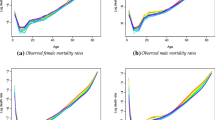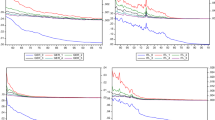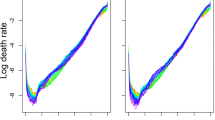Abstract
Mortality rates are often disaggregated by different attributes, such as sex, state, education, religion, or ethnicity. Forecasting mortality rates at the national and sub-national levels plays an important role in making social policies associated with the national and sub-national levels. However, base forecasts at the sub-national levels may not add up to the forecasts at the national level. To address this issue, we consider the problem of reconciling mortality rate forecasts from the viewpoint of grouped time-series forecasting methods (Hyndman et al. in, Comput Stat Data Anal 55(9):2579–2589, 2011). A bottom-up method and an optimal combination method are applied to produce point forecasts of infant mortality rates that are aggregated appropriately across the different levels of a hierarchy. We extend these two methods by considering the reconciliation of interval forecasts through a bootstrap procedure. Using the regional infant mortality rates in Australia, we investigate the one-step-ahead to 20-step-ahead point and interval forecast accuracies among the independent and these two grouped time-series forecasting methods. The proposed methods are shown to be useful for reconciling point and interval forecasts of demographic rates at the national and sub-national levels, and would be beneficial for government policy decisions regarding the allocations of current and future resources at both the national and sub-national levels.




Similar content being viewed by others
References
Abdel-Latif, M. E., Bajuk, B., Oei, J., Vincent, T., Sutton, L., & Lui, K. (2006). Does rural or urban residence make a difference to neonatal outcome in premature birth? A regional study in Australia. Archives of Disease in Childhood: Fetal & Neonatal, 91(4), F251–F256.
Akaike, H. (1974). A new look at the statistical model identification. IEEE Transactions on Automatic Control, 19(6), 716–723.
Athanasopoulos, G., Ahmed, R. A., & Hyndman, R. J. (2009). Hierarchical forecasts for Australian domestic tourism. International Journal of Forecasting, 25(1), 146–166.
Chernick, M. R., & LaBudde, R. A. (2011). An introduction to bootstrap methods with applications to R. Hoboken, NJ: Wiley.
Coale, A. J., & Banister, J. (1996). Five decades of missing females in China. Proceedings of the American Philosophical Society, 140(4), 421–450.
Dangerfield, B. J., & Morris, J. S. (1992). Top-down or bottom-up: Aggregate versus disaggregate extrapolations. International Journal of Forecasting, 8(2), 233–241.
Drevenstedt, G. L., Crimmins, E. M., Vasunilashorn, S., & Finch, C. E. (2008). The rise and fall of excess male infant mortality. Proceedings of the National Academy of Sciences of the United States of America., 105(13), 5016–5021.
Flatø, M., & Kotsadam, A. (2014). Droughts and gender bias in infant mortality in sub-Saharan Africa. Working paper No. 2. Department of Economics, University of Oslo. Retrieved from: https://www.sv.uio.no/esop/forskning/aktuelt/aktuelle-saker/2015/dokumenter/flato-kotsadam.pdf.
Fuse, K., & Crenshaw, E. M. (2006). Gender imbalance in infant mortality: A cross-national study of social structure and female infanticide. Social Science & Medicine, 62(2), 360–374.
Gaille, S. A., & Sherris, M. (2015). Causes-of-death mortality: What do we know on their dependence? North American Actuarial Journal, 19(2), 116–128.
Girosi, F., & King, G. (2008). Demographic forecasting. Princeton, NJ: Princeton University Press.
Gneiting, T., & Raftery, A. E. (2007). Strictly proper scoring rules, prediction and estimation. Journal of the American Statistical Association, 102(477), 359–378.
Griffiths, P., Matthews, Z., & Hinde, A. (2000). Understanding the sex ratio in India: A simulation approach. Demography, 37(4), 477–488.
Gross, C. W., & Sohl, J. E. (1990). Disaggregation methods to expedite product line forecasting. Journal of Forecasting, 9(3), 233–254.
Hyndman, R. J. (2010). addb: Australian demographic data bank [computersoftwaremanual]. Retrieved from: http://robjhyndman.com/software/addb/.
Hyndman, R. J., Ahmed, R. A., Athanasopoulos, G., & Shang, H. L. (2011). Optimal combination forecasts for hierarchical time series. Computational Statistics and Data Analysis, 55(9), 2579–2589.
Hyndman, R. J., & Khandakar, Y. (2008). Automatic time series forecasting: The forecast package for R. Journal of Statistical Software, 27(3), 1–22.
Hyndman, R. J., Koehler, A., Ord, J., & Snyder, R. (2008). Forecasting with exponential smoothing: the state-space approach. New York: Springer.
Hyndman, R. J., Lee, A. J., & Wang, E. (2016). Fast computation of reconciled forecasts for hierarchical and grouped time series. Computational Statistics and Data Analysis, 97, 16–32.
Japanese Mortality Database. (2016). National Institute of Population and Social Security Research[computersoftwaremanual]. Retrieved from http://www.ipss.go.jp (data downloaded on 18/June/2015).
Kahn, K. B. (1998). Revisiting top-down versus bottom-up forecasting. The Journal of Business Forecasting, 17(2), 14–19.
Kilian, L. (2001). Impulse response analysis in vector autoregressions with unknown lag order. Journal of Forecasting, 20(3), 161–179.
Kinney, W. R. (1971). Predicting earnings: Entity versus subentity data. Journal of Accounting Research, 9(1), 127–136.
Kwiatkowski, D., Phillips, P. C. B., Schmidt, P., & Shin, Y. (1992). Testing the null hypothesis of stationarity against the alternative of a unit root: How sure are we that economic time series have a unit root? Journal of Econometrics, 54(1–3), 159–178.
Lütkepohl, H. (2006). New introduction to multiple time series analysis. Berlin: Springer.
Murray, C. J. L., & Lopez, A. D. (1997). Alternative projections of mortality and disability by cause 1990–2020: Global burden of disease study. The Lancet, 349(9064), 1498–1504.
Park, C. B., & Cho, N. (1995). Consequences of son preference in a low-fertility society: Imbalance of the sex ratio at birth in Korea. Population and Development Review, 21(1), 59–84.
Pongou, R. (2013). Why is infant mortality higher in boys than in girls? A new hypothesis based on preconception environment and evidence from a large sample of twins. Demography, 50(2), 421–444.
R Core Team. (2016). R: A language and environment for statistical computing [computersoftwaremanual]. Vienna, Austria. Retrieved from: http://www.R-project.org/.
Rahman, M., & DaVanzo, J. (1993). Gender preference and birth spacing in Matlab, Bangladesh. Demography, 30(3), 315–332.
Schwarzkopf, A. B., Tersine, R. J., & Morris, J. S. (1988). Top-down versus bottom-up forecasting strategies. International Journal of Production Research, 26(11), 1833–1843.
Sefton, J., & Weale, M. (2009). Reconciliation of national income and expenditure: Balanced estimates of national income for the United Kingdom, 1920–1990. Cambridge, MA: Cambridge University Press.
Shang, H. L., & Hyndman, R. J. (2016). Grouped functional time series forecasting: An application to age-specific mortality rates. Working paper No. 04/16. Monash University. Retrieved from http://business.monash.edu/econometrics-and-business-statistics/research/publications/ebs/wp04-16.pdf.
Shlifer, E., & Wolff, R. W. (1979). Aggregation and proration in forecasting. Management Science, 25(6), 594–603.
Stone, R., Champernowne, D. G., & Meade, J. E. (1942). The precision of national income estimates. The Review of Economic Studies, 9(2), 111–125.
Vinod, H. D. (2004). Ranking mutual funds using unconventional utility theory and stochastic dominance. Journal of Empirical Finance, 11(3), 353–377.
Vinod, H. D., & López-de-Lacalle, J. (2009). Maximum entropy bootstrap for time series: The meboot R package. Journal of Statistical Software, 29(5), 1–19.
Weale, M. (1988). The reconciliation of values, volumes and prices in the national accounts. Journal of the Royal Statistical Society, Series A, 151(1), 211–221.
Zellner, A., & Tobias, J. (2000). A note on aggregation, disaggregation and forecasting performance. Journal of Forecasting, 19(5), 457–469.
Zivot, E., & Wang, J. (2006). Modeling financial time series with S-PLUS. New York: Springer.
Author information
Authors and Affiliations
Corresponding author
Appendix: Maximum Entropy Bootstrap Algorithm
Appendix: Maximum Entropy Bootstrap Algorithm
An overview of the maximum entropy bootstrap algorithm is provided for generating a random realization of a univariate time series \(x_t\). Consult Vinod (2004) for more details and an example. In the maximum entropy bootstrap algorithm, the following steps are followed:
-
1.
Sort the original data in increasing order to create order statistics \(x_{(t)}\) and store the ordering index vector.
-
2.
Compute intermediate points \(z_t = \frac{x_{(t)}+x_{(t+1)}}{2}\) for \(t=1,\dots ,n-1\) from the order statistics.
-
3.
Compute the trimmed mean, denoted by \(m_{\text {trim}}\) of deviations \(x_t - x_{t-1}\) among our consecutive observations. Compute the lower limit for the left tail as \(z_0 = x_{(1)} - m_{\text {trim}}\) and the upper limit for the right tail as \(z_n = x_{(n)}+m_{\text {trim}}\). These limits become the limiting intermediate points.
-
4.
Compute the mean of the maximum entropy density within each interval such that the “mean-preserving constraint” is satisfied. Interval means are denoted as \(m_t\). The means for the first and last intervals have simpler formulas:
$$\begin{aligned} \left\{ \begin{array}{ll} m_1=0.75 x_{(1)}+0.25 x_{(2)} \\ m_k = 0.25x_{(k-1)} + 0.5 x_{(k)} + 0.25 x_{(k+1)}, \qquad k=2,\dots ,n \\ m_n = 0.25 x_{(n-1)} + 0.75 x_{(n)} \end{array} \right. \end{aligned}.$$ -
5.
Generate random numbers from Uniform[0, 1], and compute sample quantiles of the maximum entropy density at those points and sort them.
-
6.
Re-order the sorted sample quantiles by using the ordering index of Step 1. This recovers the time-dependence relationships of the originally observed data.
-
7.
Repeat Steps 2 to 6 several times.
Rights and permissions
About this article
Cite this article
Shang, H.L. Reconciling Forecasts of Infant Mortality Rates at National and Sub-National Levels: Grouped Time-Series Methods. Popul Res Policy Rev 36, 55–84 (2017). https://doi.org/10.1007/s11113-016-9413-1
Received:
Accepted:
Published:
Issue Date:
DOI: https://doi.org/10.1007/s11113-016-9413-1




